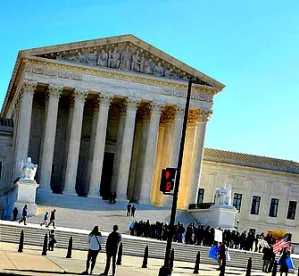As we await tomorrow's batch of opinions, let's take a moderately deep dive into Monday's partisan-gerrymandering decisions, Gill v. Whitford (No. 16-1161) and Benisek v. Lamone (No. 17-333). As we reported earlier, the Supreme Court punted on the ultimate issue in the cases, namely whether the Democratic challengers to Wisconsin's redistricting plan (in Gill) and the Republican challengers to a gerrymandered Maryland district (in Benisek) had presented justiciable constitutional claims. However, in each case the litigation will continue in the lower courts and the competing opinions in Gill offer hints as to where some of the Justices may come out when (not if) the ultimate issue returns to them. The trouble is, the views of Justice Kennedy, who is apparently still the swing justice on this issue fourteen years after his cryptic concurrence in Vieth v. Jubelirer (2004), remain unknown. In Vieth, Kennedy agreed with a plurality of four more conservative Justices that the challenge to the particular Pennsylvania map at issue was nonjusticiable, but he held open the possibility that a workable standard for reviewing partisan-gerrymandering claims might emerge in the future. Ever since then, challengers have been trying to come up with a standard that might satisfy Kennedy and lead to a ruling that partisan gerrymandering violates the Constitution.
The plaintiffs in Gill thought they'd come up with the right approach. Seizing on a law review article that developed a new metric for measuring partisan symmetry called the "efficiency gap," the plaintiffs in Gill convinced a three-judge District Court that Wisconsin's 2010 redistricting plan disproportionately favored Republican candidates by "cracking" and "packing" Democratic voters—that is, by both dispersing registered Democrats across districts and concentrating them within the few districts in which they did constitute a majority. As the plaintiffs showed, the plan allowed Republicans to win 60 of 99 Assembly seats in 2012 despite receiving only 48.6% of the statewide vote. In light of this marked disparity, the District Court held that the redistricting plan was an unconstitutional partisan gerrymander.
On direct appeal to the Supreme Court many hoped that the new metric (or a different theory proposed in Benisek) might satisfy Justice Kennedy and lead a majority of the Court to recognize partisan gerrymandering claims as justiciable. Others surely hoped that Kennedy would finally join with the Court's conservatives in concluding, once and for all, that partisan gerrymandering claims are nonjusticiable. Both sides were disappointed, however, as the Court punted on the justiciability issue and instead held that the plaintiffs had failed to prove standing. Writing for the Court, the Chief Justice emphasized that the claim the plaintiffs actually litigated—that their votes were diluted by the redistricting plan—is necessarily "district specific." To have standing to pursue that claim, the plaintiffs had to show that their specific districts were "packed" or "cracked" and, as a result, that their individual votes were diluted. At trial, however, "not a single plaintiff sought to prove that he or she lives in a cracked or packed district." Instead, they focused on proving that the redistricting plan skewed the statewide political map in favor of Republicans, creating statewide "partisan asymmetry" and harm to plaintiffs' interest in their "collective representation in the legislature." That kind of harm is insufficient to establish the individualized injury in fact required for standing, the Chief wrote, in a portion of the opinion that all nine Justices joined. As the Chief put it, the Court's job is "to vindicate the individual rights of the people appearing before it" and not to "vindicat[e] generalized partisan preferences."
Generally, when the Court finds that a plaintiff lacks standing, that's the end of the case. But rather than directing the dismissal of the Gill complaint, the Court remanded to give the plaintiffs an opportunity to present evidence of the "concrete and particularized," district-specific, harm required to establish standing. In doing so, the Chief recognized that the case involved an "unsettled kind of claim . . . the contours and justiciability of which" the Court has not yet resolved. Justices Thomas and Gorsuch wrote separately to say that they would have dismissed the case entirely because the plaintiffs had "more-than-ample opportunity" to prove standing.
Justice Kagan, joined by Ginsburg, Breyer, and Sotomayor, penned a concurring opinion that reads like a playbook for the plaintiffs to follow on remand. To prove packing or cracking of their districts, she noted, the plaintiffs could, for example, show that their votes would carry more weight if an alternative map—drawn using traditional redistricting principles and without regard to partisan advantage—were used. If, as alleged, the unified Republican government in Wisconsin had set out to control as many state legislative seats as possible, plaintiffs should be able to present packing and cracking evidence on a district by district basis to establish standing. Justice Kagan also emphasized that evidence of statewide harm can still be considered in deciding the merits of such equal protection claims and in fashioning an appropriate remedy.
In an indirect overture to Justice Kennedy (who she apparently expects to remain on the Court for the next partisan-gerrymandering case), Justice Kagan also laid out the contours of a potential First Amendment challenge to partisan gerrymanders, an associational rights claim that would present "a distinct harm from vote dilution." (The plaintiffs had not raised a First Amendment claim, but Justice Kennedy asked a few questions at oral argument suggesting he might sympathize with this angle and is, of course, one of the most ardent First Amendment proponents on the Court.) Under this theory, partisan gerrymanders deprive members of a "disfavored" political party of their collective political strength in violation of their free-association rights under the First Amendment. They will have more trouble registering voters, fundraising, recruiting candidates, and attracting volunteers—harms that are not district-specific but should be sufficient to establish standing to pursue a First Amendment claim. Justice Kagan's discussion of a possible First Amendment claim drew a pointed response from the Chief Justice, who called her comments "speculative and advisory" and made it clear that the totality of the Court's reasoning "is set forth in this opinion and no other." That said, it's hard to imagine the plaintiffs not pursuing a First Amendment theory on remand, in addition to attempting to make out a district-specific equal protection claim.
In some ways, Benisek, the Maryland redistricting case, might have provided the Justices with the opportunity they felt they lacked in Gill. The case involved a challenge to a specific district—Maryland's 6th, which the longstanding Republican incumbent had won by almost 30% in 2010, but then lost by 20% two years later after the Democratic legislature redrew the district lines. And the plaintiffs raised a First Amendment challenge, arguing that the district was redrawn in retaliation against them for their political views. However, the specific issue before the Court was narrower—whether the District Court erred in denying the plaintiffs' motion for a preliminary injunction and staying proceedings until the Supreme Court decided Gill.
In a per curiam decision, the Court had little trouble concluding that the District Court had not abused its discretion. The plaintiffs had delayed six years and three general elections before seeking a preliminary injunction, and the public interest in preserving orderly elections while the Supreme Court considered how to address partisan gerrymandering claims, weighed against issuing a preliminary injunction. Therefore, even if the plaintiffs were likely to succeed on the merits—a question the per curiam opinion did not address—the other prongs of the test plainly weighed against a preliminary injunction, and therefore in favor of affirming the District Court. That means the plaintiffs can resume their challenge on remand, but the existing map will be in place for the 2018 midterm elections.
So, despite almost a full term's worth of anticipation, neither Gill nor Benisek resulted in any change in the law on partisan gerrymandering. The issue is sure to return to the Court (whether in a challenge to Wisconsin's map, or Maryland's, or another pending challenge out of North Carolina), but it remains to be seen whether Justice Kennedy will find a satisfactory "workable" solution . . . or, indeed, whether he will still be on the Court when the issue returns.






 />i
/>i

